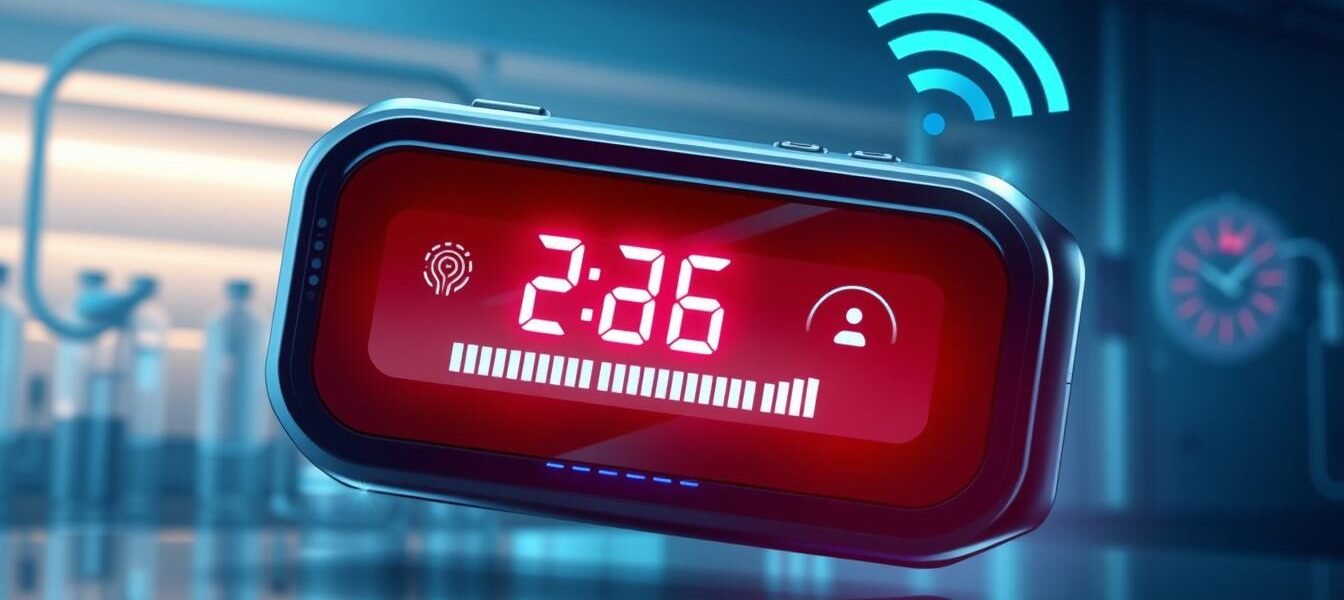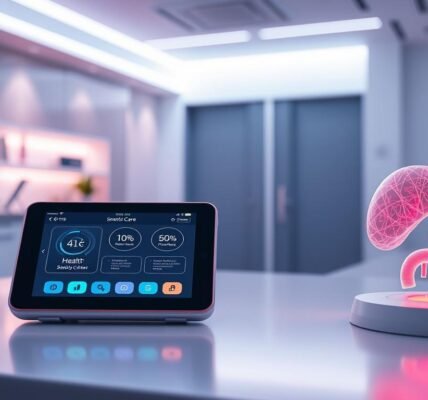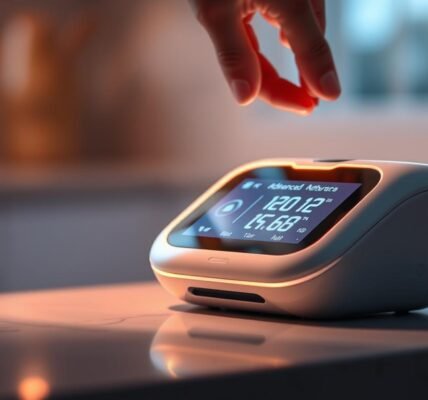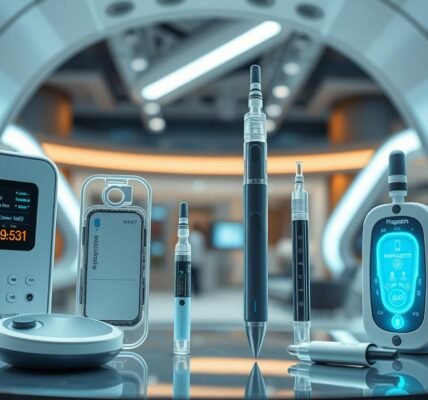“The greatest weapon against stress is our ability to choose one thought over another,” said William James. As we enter 2025, continuous glucose monitors (CGMs) have changed how we manage diabetes. These devices give real-time data, helping you make better health choices. Next year, CGMs will get even better, with longer wear, easier access, and better phone app connections.
The future of CGMs looks bright, with companies like Senseonics aiming to double their users to 12,000 by 2025. Their 365-day CGM implant is a big step forward. With 38 million people in the U.S. living with diabetes, the need for good blood sugar tracking is growing fast1. As CGM tech gets better, you can expect even more help in managing your health, especially for pregnant women at risk for diabetes2.
Key Takeaways
- Continuous glucose monitors have advanced significantly, providing real-time monitoring.
- 2025 will see a push for over-the-counter CGM systems, increasing accessibility.
- Sensoonics plans to expand its user base significantly with longer-lasting sensors.
- The CGM market is projected to approach $20 billion by 2030.
- New CGM integrations with insulin delivery systems promise enhanced functionality.
- Adherence and engagement in diabetes management are improving with new technologies.
- Innovations in CGM design focus on user-friendliness and extended wear capabilities.
Introduction to Continuous Glucose Monitors
Continuous glucose monitoring systems (CGMs) are key for managing diabetes well. They are a big step forward in CGM technology. They let users check their blood sugar levels without needing to prick their fingers often.
CGMs have sensors under the skin that track glucose levels in the body’s fluid. They give real-time data. This helps users make better choices about their lifestyle.
These devices are very reliable and can greatly improve health. In the U.S., over 38 million adults have diabetes. This number is expected to grow to more than 54 million by 20303. CGMs can be worn for 6 to 14 days, making managing diabetes easier.
For people who take insulin, using CGMs can be very helpful. The NHS suggests using CGMs for all with type 1 diabetes in England and Wales4. The cost of these systems, including the initial and ongoing costs, is something to think about4. But, the benefits of knowing your glucose levels in real-time often make the cost worth it.
New developments in glucose monitoring innovations have led to products like the Freestyle Libre 2 Plus. It’s safe for younger kids and can be worn for 15 days4. As CGM technology gets better, it becomes more part of daily life for those with diabetes. It offers features to help improve health and well-being.
The Evolution of CGM Technology
In the last 20 years, CGM technology has changed how we manage diabetes. New glucose sensor technology makes readings more accurate and easier to use. The market for these systems is expected to grow from USD 7.5 billion in 2024 to USD 28.2 billion by 20355. Companies like Dexcom and Abbott Laboratories have made these systems more available and effective6.
The FDA has approved devices like Stelo and Lingo for over-the-counter use. This is great news for those with limited healthcare coverage6. It shows a focus on making technology that fits the needs of users. Now, systems like rtCGM give instant feedback and alerts for blood sugar levels5.
Looking ahead to 2025, the goal is to make glucose monitoring better for patients. This includes making devices more comfortable and easy to use, especially for type 2 diabetes patients. With over 422 million people worldwide affected, the need for better CGMs is clear.
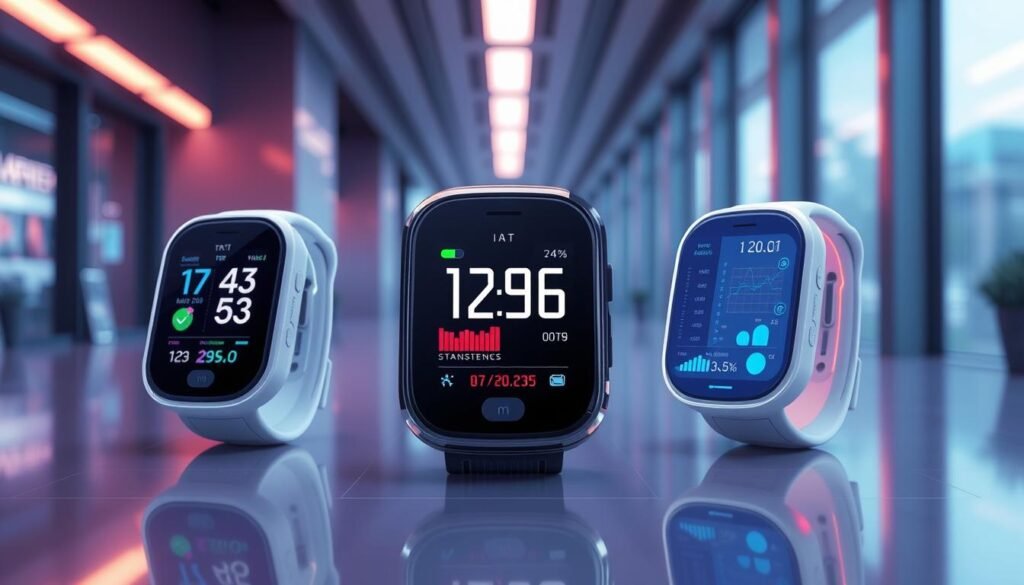
| Year | Market Size (USD Billion) | Projected Growth (CAGR) |
|---|---|---|
| 2024 | 7.5 | – |
| 2035 | 28.2 | 12.8% |
Advances in CGM technology and making it more accessible will help more people manage their diabetes better, as expected in 2025.
“The potential for non-invasive glucose monitoring is on the horizon, driving forward the future of diabetes management systems.”
CGM devices are getting better, showing a strong commitment to improving care for diabetics.
For people with diabetes, these advancements mean better technology and more personalized healthcare.
Continuous Glucose Monitors 2025: A Closer Look
By 2025, continuous glucose monitoring systems will have new features. These advancements will make managing blood sugar easier for users. You can expect a more advanced system that improves your experience and gives accurate readings.
Overview of 2025 Features
In 2025, CGMs like Medtronic’s MiniMed 780G will be used by about 600,000 people. These next-gen systems will help you stay in range more often. They will also keep Time Below Range low, at just 1.5%7.
These new models will last longer and be more accurate. This means better diabetes management for everyone.
Comparison with Previous Models
2025 models are a big step up from earlier ones. They don’t need as much calibration because they adjust themselves. You’ll also get updates on your phone right away, helping you act fast on blood sugar changes.
Real data shows users of the Omnipod 5 system are doing better, with a TIR rate of 74%. This is a big improvement from earlier models78.
| CGM Model | Estimated User Base | TIR Rate (%) | TBR Rate (%) |
|---|---|---|---|
| Medtronic MiniMed 780G | ~600,000 | 80 | 1.5 |
| Tandem Control-IQ | ~300,000 | 71 | 1.5 |
| Insulet Omnipod 5 | 235 | 74 | 1.3 |
| mylife Loop | ~60,000 | 73 | 2.3 |
| Diabeloop | ~12,000 | 72 | 0.9 |
This table shows how much better TIR and TBR rates are in newer models. These improvements will help you manage your glucose better7.
OTC Approval and Its Impact on Accessibility
The FDA’s recent approval of OTC CGM systems has made it easier for more people to get them. Now, you can buy devices to monitor your blood sugar without a doctor’s prescription. This change helps those with diabetes and anyone wanting to improve their health through glucose monitoring.
Understanding OTC CGM Systems
The Lingo and Libre Rio systems by Abbott are among the approved devices. Lingo is for adults 18 and older, offering insights and coaching for 14 days. The Libre Rio is for adults 18 and older with type 2 diabetes, providing glucose data for 15 days and measuring 40 to 400 mg/dL9.
The Dexcom Stelo is also set to hit the market in March 2024. It’s for adults not using insulin, lasting up to 15 days. It tracks glucose every 15 minutes through a smartphone app10.
Benefits of Over-the-Counter Availability
With CGM systems available OTC, patients are more likely to use them. This makes it easier for people to manage their diabetes on their own. It’s especially important for communities that have been underserved, helping to make health management more accessible910.
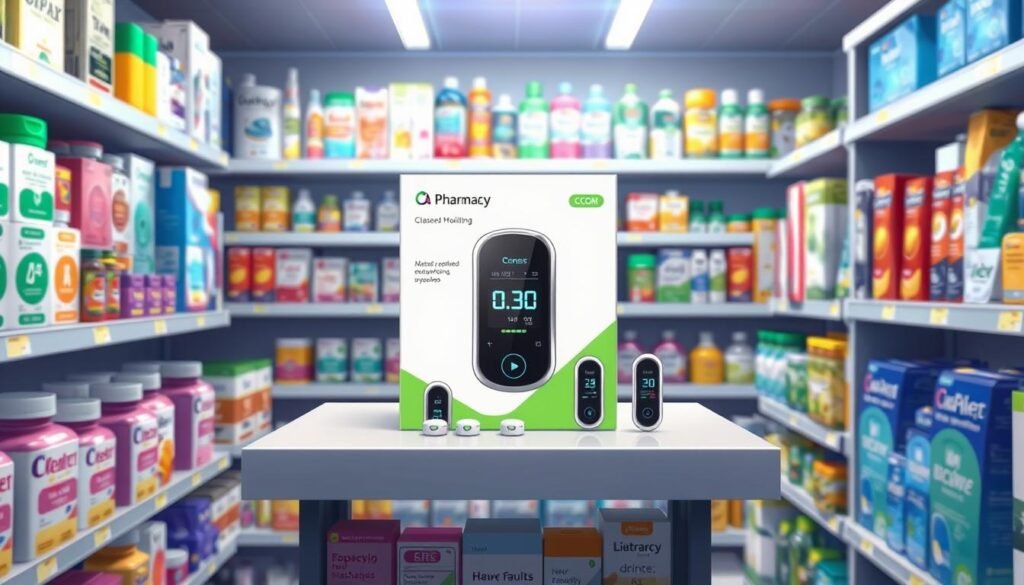
Key Players in the CGM Market
The CGM market is getting more competitive. Companies like Abbott, Dexcom, and Medtronic are leading with new tech. They focus on making devices more accurate and easy to use.
These companies are key in shaping the future of glucose monitoring. They keep improving their products to meet what users need.
Leading CGM Systems in 2025
In 2025, Dexcom’s new CGM system will be a big hit. It’s all about making things easy and reliable for users. Medtronic’s MiniMed system is also getting better, with more data sharing and precise sensors.
This focus on quality is important. The CGM market is expected to grow a lot. It will go from USD 4.60 billion in 2023 to even bigger by 2030. This growth is because more people have diabetes worldwide1112.
New Innovations by Major Brands
Big brands are always coming up with new ideas. They use wireless tech and mobile apps to make things better. Dexcom’s devices let users check their glucose levels easily.
Medtronic is working with tech companies to make their devices even better. They’re focusing on longer sensor life and more accurate data. This means a better experience for people with diabetes12.
Advanced Features in CGM Devices
Continuous glucose monitoring systems have made big strides. They now offer features that help manage diabetes every day. Key advancements include real-time glucose monitoring and better mobile connectivity. These features boost patient control and involvement in health care.
Real-time Glucose Monitoring Capabilities
Modern CGMs, like the Stelo and Lingo systems, show real-time glucose monitoring. They give users instant updates on their blood sugar levels. This quick info helps users make timely changes to their diet or insulin doses.
It also makes managing diabetes easier and more effective. Studies show that using these systems leads to better health outcomes. This is because users are more likely to stick to their treatment plans13.
Mobile Connectivity and Smartphone Integration
CGM technology has taken a big step forward with mobile health solutions. Devices like the Abbott FreeStyle Libre 3 and Dexcom G7 connect to smartphones. This lets users track their glucose levels and receive alerts on their phones.
These apps offer customizable alerts and help track glucose trends. They make it easy to share data with doctors. The Libre 3 and Dexcom G7 have high accuracy, with Overall MARDs of 7.9% and 8.2%, respectively14.
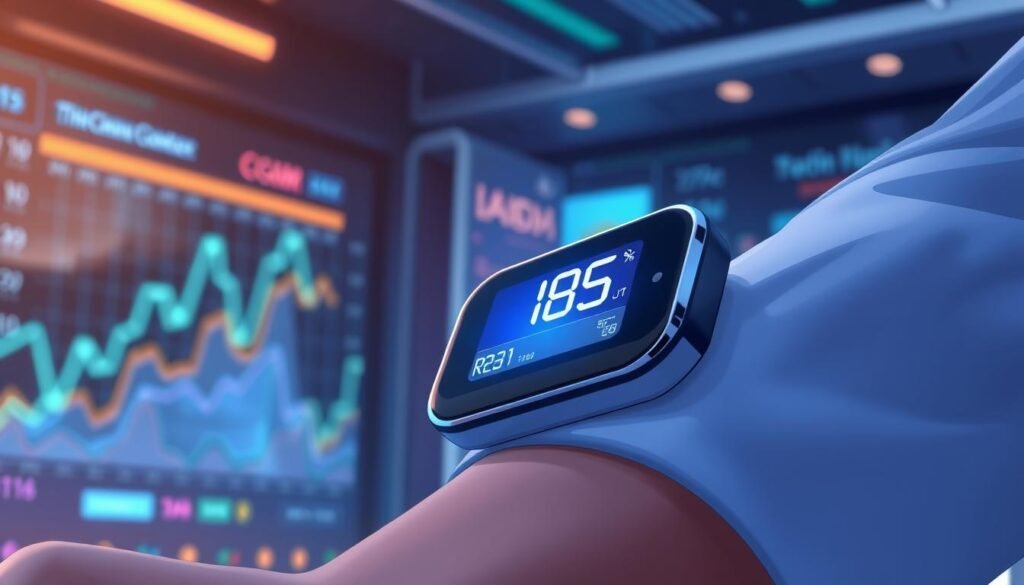
Wearable Continuous Glucose Monitors
In 2025, wearable continuous glucose monitors became very popular. They are easy to use and fit well into your daily life. These devices help you keep track of your glucose levels without getting in the way.
They make it easier to stick to your diabetes management plan. This leads to better health outcomes.
Benefits of Wearable Technology
Wearable glucose monitors have many benefits for managing diabetes. Some key advantages are:
- Convenience: They give you real-time data, helping you make better health choices.
- Comfort: These devices are light and don’t get in the way, making them comfortable to wear.
- Simplicity: They automatically capture data, so you don’t have to do finger-prick tests as often.
- Data Integration: Many devices connect to smartphones, letting you see trends over time.
Trends in Wearable CGM Devices
The CGM market is always changing, with new trends to improve your experience. Some notable trends are:
- Adhesive-free sensors that are more comfortable and easy to use.
- Compatibility with fitness trackers for a more complete health picture.
- More accurate sensors, with the latest ones having a MARD of about ±10%15.
- Technological improvements that make these devices more affordable and accessible.
The latest in wearable CGM devices fits well with the bigger trends in personal health. They are key for managing diabetes effectively.
CGM Market Forecast and Trends in 2025
The continuous glucose monitoring market is growing fast. This is thanks to more people getting diabetes and better glucose monitoring systems. By 2023, the market was worth about $6.32 billion. It’s expected to hit $13.06 billion by 2032, growing at 8.40% each year16.
By 2025, new technologies will make CGM even more valuable. We can expect big improvements in device features and how users experience them.
Projected Growth of CGM Technology
More people want to manage their diabetes well. This is why the need for glucose monitoring systems is rising. It’s estimated that 537 million adults have diabetes now. This number could jump to 643 million by 203016.
This rise in diabetes means we need better CGM devices. These devices help monitor glucose levels accurately and on time.
Emerging Markets for CGM Devices
Asia and Africa are seeing a big boost in CGM use. This is because healthcare systems are getting better and more people have access to technology. In China, only 6.9% of type 1 diabetes patients use CGM. But by 2030, this number could jump to 38%16.
In India, over half of type 1 diabetes patients already use CGM devices. This shows a trend of more people using these devices in areas where access was once limited16. These markets are key to making healthcare fairer and improving diabetes care globally.

Patient Compliance and Engagement with CGMs
Continuous glucose monitors (CGMs) are changing how we manage diabetes. They give constant updates on blood sugar levels. This helps people understand their diabetes better and manage their health more effectively.
CGMs send alerts and reminders. This makes it easier to stay on track with your health journey17.
How CGMs Improve Patient Adherence
CGMs help people take a more active role in managing their diabetes. They provide real-time data that helps you make better choices. This leads to higher satisfaction with diabetes care and better adherence to treatment plans18.
Using CGMs can also reduce diabetes-related complications. This improves your long-term health outcomes.
Encouraging Active Participation in Diabetes Management
CGM technology encourages users to work closely with their healthcare providers. Sharing data easily leads to better diabetes management. With mobile apps, you can see your glucose levels and trends easily.
This makes it easier to discuss your treatment with your doctor. It helps create personalized plans that improve your health that benefit your overall health. It boosts your confidence and makes you feel more in control of your health journey.
Integration of AI and Data Analytics in CGMs
The use of AI in diabetes care is changing how we use continuous glucose monitors (CGMs). These devices are no longer just for tracking glucose levels. They have become smart tools that analyze trends and predict changes. AI algorithms offer personalized advice based on your health needs, helping you manage diabetes better.
Dexcom has introduced a new AI feature for its glucose sensors. This innovation got FDA approval in March for the Stelo model. It’s a big step forward in diabetes care technology19.
Role of AI in Diabetes Management
AI is leading the way in diabetes care, making it easier and more effective. It uses data from CGMs to give you insights to act on. This way, you can keep your glucose levels stable.
These AI-powered CGMs also make it easier to understand how your choices affect your health. Even though no AI devices are FDA-approved yet, other areas are already using this tech19.
Advanced Data Analytics Features in CGMs
CGMs now come with advanced analytics that offer deep insights into glucose patterns. They show how your lifestyle choices affect your glucose levels. This helps you make better decisions about your health.
AI makes managing diabetes easier, leading to better patient care. The market expects a big growth in Remote Patient Monitoring. It’s set to jump from $1.45 billion in 2021 to $4.07 billion by 203020.
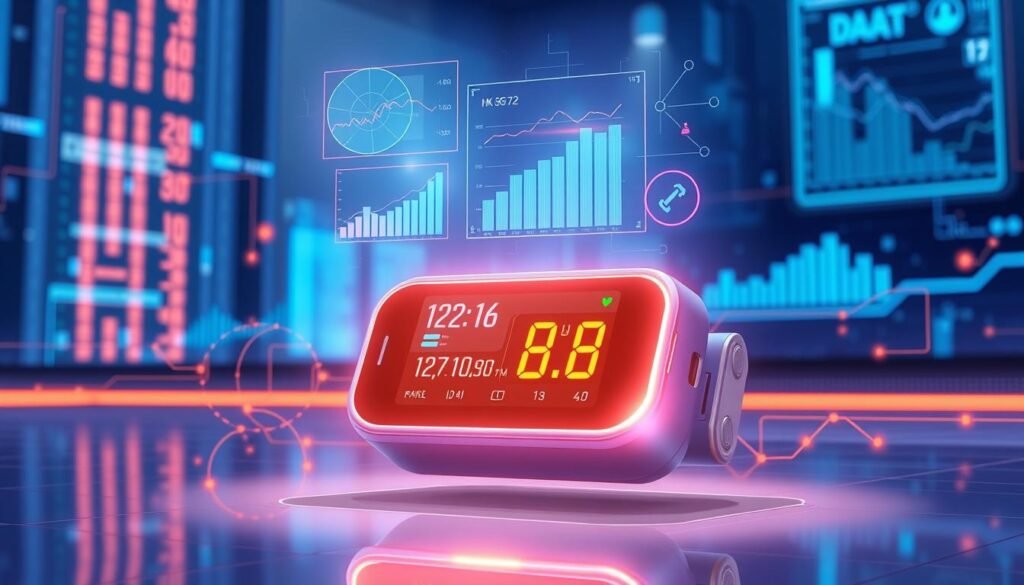
The Future of Continuous Glucose Monitoring Systems
The world of continuous glucose monitors (CGMs) is changing fast. New features and technologies are making diabetes management better. Soon, CGMs will offer non-invasive sensors and real-time data sharing with doctors.
This will help users make better health choices. For more on these advancements, check out glucose monitoring innovations.
Innovative Features on the Horizon
CGMs will soon track more than just glucose. They will monitor overall health. This will make tracking easier and more effective.
Already, 6 million people worldwide use Abbott’s FreeStyle Libre CGM. This shows how much people need these devices for their health21. New technologies will help more people, making diabetes care more personal.
Potential Developments in the CGM Industry
The CGM industry is set for big changes. Soon, CGMs will track ketones too, not just glucose. This is crucial for those with diabetes.
About 38.4 million Americans have diabetes. This makes CGMs a key tool for managing the disease21. Better sensors and analytics will make CGMs even more important for health.
As more people retire, the CGM market will grow to $20 billion by 2030. This shows the huge potential of CGM technology2.
Changes in Healthcare Provider Recommendations
Continuous glucose monitor (CGM) technology is getting better. Healthcare providers are now giving more personalized advice on using CGMs. This change helps people with diabetes or those looking to improve their health get the right tools for managing their diabetes.
The American Diabetes Association (ADA) has updated its guidelines. They now recommend CGMs for adults with type 2 diabetes on certain medications. This shows how important CGMs are becoming in managing diabetes22.
The Role of Healthcare Providers in Advising CGMs
Healthcare providers are key in helping patients choose the right CGMs. With more Medicare coverage, they can help more people get these devices. This can lead to better blood sugar control.
Providers should teach patients about CGMs. They should explain how these devices work and how to use the data they provide. This helps patients manage their diabetes better, especially those who are underserved23.
Educating Patients on New Technologies
It’s important for healthcare providers to teach patients about CGMs. They need to make sure patients understand how to use the data from CGMs. This helps patients manage their diabetes more effectively.
By educating patients, providers help them take charge of their health. This is crucial as diabetes management tools keep evolving. It ensures patients can make informed choices about their health22
Comparing CGM Options for Users
Choosing the right Continuous Glucose Monitor (CGM) is key for managing diabetes well. It’s important to know the factors for choosing a CGM when you’re deciding. Your health goals, lifestyle, and how well it works with other health tech are crucial.
Only 13% of 30,585 adults with type 2 diabetes used a CGM, showing many could benefit24. CGM users are often younger and use more insulin, with 72% on insulin compared to 12% not24. This info helps pick devices that fit your needs.
Factors to Consider When Choosing a CGM
When looking at CGM options, consider a few key things. These include:
- Device Accuracy: Systems like the FreeStyle Libre 3 have a low MARD of 8.2 percent, beating its predecessor25.
- Cost: The FreeStyle Libre 3 system costs patients between $0 and $75 per month, making it cheaper than others25.
- Integration: Make sure your CGM works well with other diabetes devices for a better experience.
- Sensor Longevity: Check how long the sensors last and if they’re easy to swap out.
Evaluation of Key Features across CGMs
Choosing wisely means understanding each CGM’s features. Each system has different qualities such as:
| Device | Accuracy | Cost | Sensor Size | Integration |
|---|---|---|---|---|
| FreeStyle Libre 2 | MARD 9.3% | Lower than competitors | N/A | Good |
| FreeStyle Libre 3 | MARD 8.2% | $0 – $75/month | N/A | Excellent |
| Dexcom G7 | Very High Accuracy | Varies, over $200 savings possible | 60% smaller | Excellent |
Knowing these details helps you choose the right CGM for your diabetes care. For more info on CGM options, check out guidelines and coverage policies here24.
Conclusion
Looking ahead to 2025, CGM technology is set to change how we manage diabetes. These devices are getting more accurate, with some now off by just ±10% MARD. They also let you adjust insulin doses and analyze data. This leads to better control over blood sugar levels, helping those with diabetes15.
CGMs are now easier to get, thanks to OTC approval. This means more people can use them to manage their health. It’s important to know how these devices work and how they can help you6.
In short, CGM technology is heading towards a brighter future. It will give users the tools they need to take care of their health. By using these devices, we can make managing diabetes easier and healthier for everyone15 and6.
FAQ
What are the key advancements in continuous glucose monitors (CGMs) for 2025?
How do over-the-counter (OTC) CGM systems improve accessibility?
What role do mobile applications play in CGM technology?
How do wearable continuous glucose monitors differ from traditional monitoring methods?
What are the projected trends for the CGM market in 2025?
How does artificial intelligence (AI) enhance CGM functionalities?
What factors should users consider when choosing a CGM?
How do continuous glucose monitors encourage patient compliance?
Source Links
- https://www.medtechdive.com/news/senseonics-365-day-cgm-2025-sales/719717/
- https://www.chiefhealthcareexecutive.com/view/continuous-glucose-monitoring-market-is-projected-to-keep-growing
- https://www.drugtopics.com/view/examining-impact-of-continuous-glucose-monitors-on-diabetes-ashp-midyear
- https://breakthrought1d.org.uk/knowledge-support/managing-type-1-diabetes/guide-to-type-1-diabetes-technology/continuous-glucose-monitoring/
- https://www.metatechinsights.com/industry-insights/continuous-glucose-monitoring-cgm-system-market-1043
- https://www.idtechex.com/en/research-report/diabetes-management-technologies-2025-2035-markets-players-and-forecasts/1059
- https://www.diabetotech.com/blog/diabetes-technology-updates-fall-2024
- https://www.adces.org/store/online-education/detail/rt-cgm-setting-the-stage-for-a-new-standard-of-care-in-the-hospital-recorded
- https://www.pharmacytimes.com/view/fda-gives-clearance-to-2-otc-continuous-glucose-monitoring-systems
- https://www.medicaleconomics.com/view/otc-continuous-glucose-monitor-gets-nod-from-fda
- https://www.grandviewresearch.com/industry-analysis/continuous-glucose-monitoring-market
- https://www.linkedin.com/pulse/continuous-glucose-monitoring-cgm-system-market-size-forecast-patil-h6zoc
- https://www.cardiometabolichealth.org/the-new-era-of-continuous-glucose-monitoring-cgm-expanding-access-and-improving-outcomes/
- https://www.techtarget.com/pharmalifesciences/feature/Revolutionizing-Diabetes-Care-with-Advanced-CGM-Devices
- https://pmc.ncbi.nlm.nih.gov/articles/PMC5467105/
- https://finance.yahoo.com/news/global-continuous-glucose-monitoring-cgm-132000840.html
- https://www.ncbi.nlm.nih.gov/pmc/articles/PMC11207983/
- https://www.bcbsks.com/medical-policies/continuous-glucose-monitoring-0
- https://www.medtechdive.com/news/dexcom-gen-ai-feature-stelo-cgm/735918/
- https://connexiohealth.com/2025-trends/
- https://www.medicaleconomics.com/view/two-new-continuous-glucose-monitoring-systems-coming-to-market
- https://diabetes.org/newsroom/press-releases/american-diabetes-association-releases-standards-care-diabetes-2025
- https://rimidi.com/news/the-positive-impact-of-cgm-on-underserved-populations
- https://pmc.ncbi.nlm.nih.gov/articles/PMC10228889/
- https://www.usmed.com/blog/a-complete-guide-to-types-of-cgm/
